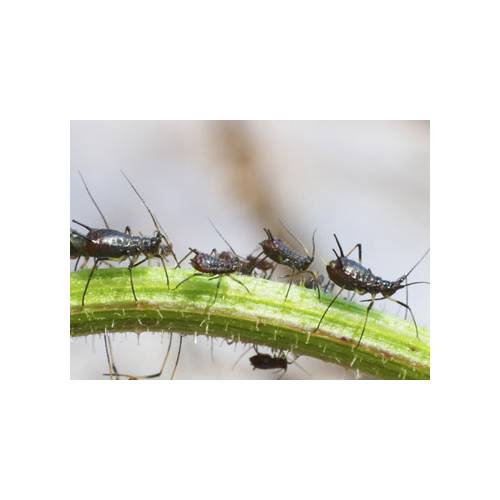
Parasites and insects
Aphids
- Details
-
Stinging aphids are the most current insects found in gardens. However, they are not the most dangerous ones for plants.
The symptoms
Growth is slowing down. On young plants and sensitive ones, the stings deform leaves: they form blisters and wrap around themselves. The aphids then become visible on the leave underside, hidden in the folds. On climbers, aphid colonies are easily seen, as they have a tendency to form a cuff of stinging insects all around the stem. Occasionally, honeydew (a sticky sweet liquid) can cover parts of the plants below the stems and leaves infested by the aphids, if it is a serious attacks. Then sooty mould can appear.
Lifecycle
Unfortunately, most of the time the presence of one aphid only is enough to lead to an entire colony. Adult aphids have the particularity of giving birth to baby aphids without laying eggs or mating! The cycle of development is then very rapid as a colony of several tens of aphids can appear in less than two weeks. The presence of ants in the proximity favours their development, as they protect them against their natural predators (ladybirds, common green lacewings, predatory shield bugs...).
How to fight aphids
When an attack of aphids is limited, remove the undesirable insects by hand or flush them away with water from a hosepipe. A pulverisation of insecticide (natural extract of pyrethrum) helps to limit the infestation if the aphids are present in large numbers. You only need to act on susceptible and young plants. An adult plant in good health does not normally suffer from the presence of aphids.
How to avoid aphids
The presence of aphids is encouraged by two factors: not enough watering (the plant suffers) and an excessive fertilising with nitrogen A weakened plant, as is the case when it is not watered enough, is more sensitive to an attack of stinging insects, like aphids. Plants that receive a fertiliser too rich in nitrogen compared to their need are also more sensitive to aphid's attacks. By keeping your plants in good health and by ensuring that the fertiliser you give them is suitable both in quality and quantity, you will avoid the proliferation of aphids on your plants.
Good to know
There is a large diversity of aphids. In a garden, there are often dozens of them, hidden away. Some aphids only attack one plant (apple trees for example) whilst others can attack any plant (like black aphids). The first ones are often more dangerous than the latter! - Photos (1)

